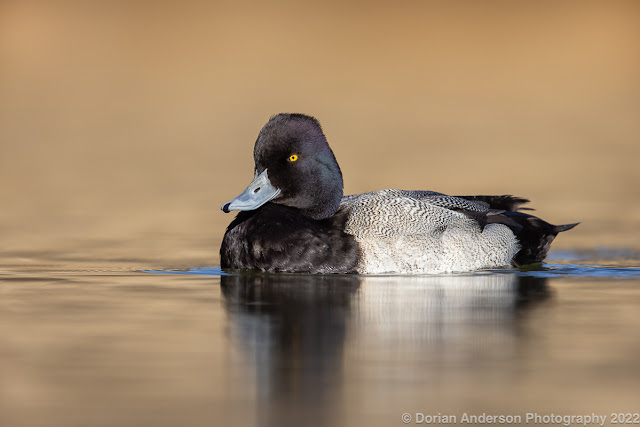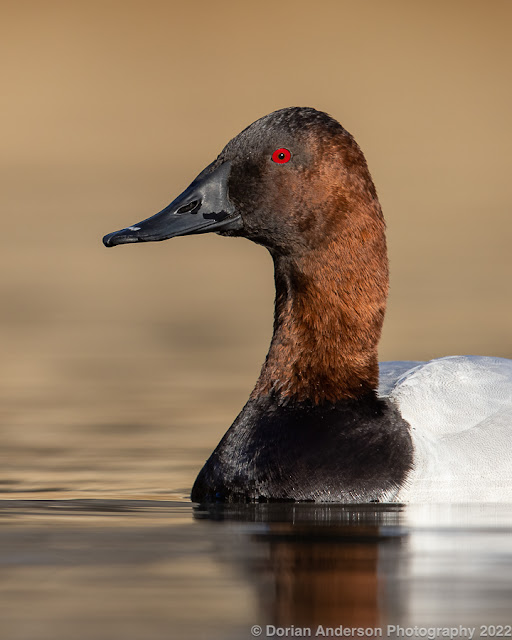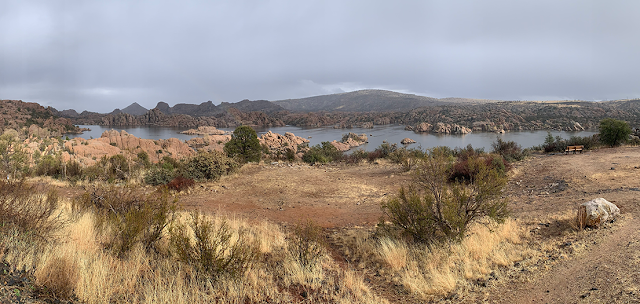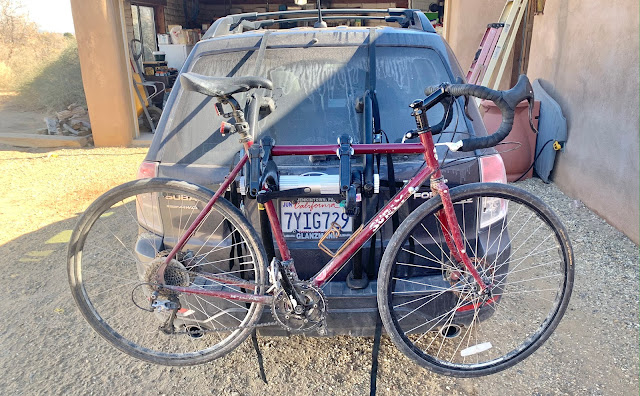I'm sorry to have let this blog lapse -- bird guiding is requiring increasing time each year -- but I figure it's worth posting a few words about my new book, Birding Under the Influence: Cycling Across America in Search of Birds and Recovery. Primarily the story of my 18,000-mile, bird-motivated bicycle trip around the lower 48 states, the adventure narrative is also an honest look at the alcoholism and substance abuse which preceded my departure. Beyond the birds I seek, I write about the people I meet along the road, the incredible array of landscapes I experience, and the overdue introspection which thousands of solitary hours permitted. Rather than rehash the entire story, I'll point you here to read more about and buy the book.
You can also check out my new website, www.doriananderson.com
Monday, October 30, 2023
Post #217 - MY BOOK IS FINALLY FINISHED AND AVAILABLE!!!
Monday, June 20, 2022
Post # 216 - Warblers in the House!
The transcontinental crazyiness continues!!! I was in Asheville, North Carolina when I posted on May 4, and I've since visited Kentucky, Ohio, and Michigan while guiding for Tropical Birding and Tennessee, Indiana, and Illinois as part of my pet-sitting adventure. I've been fortunate to see a lot of migrating songbirds along my spring arc, and I'll use this post to share a bunch of recent warbler frames. Songbirds are the weakest part of my portfolio (shorebirds are the strongest), so it's great to grow my collection with new species!
First up is an obliging Protonotary Warbler which I found in Meeman-Shelby State Forest just outside of Memphis, Tennessee. A couple cycles of audio lured this curious individual into a fallen tree, and I was able to capture a couple frames as the bird bounced around the trunk and branches.
I'm even happier with this next frame because of the unique foliage/setting. Sandpipers, herons, and ducks are some of my favorite subjects, but their wide open and watery surrounds don't change much from place to place. In those instances, I really need the lighting to imbue the frame with color, mood, and character. However, that's not the case when shooting in forest as every perch and setting is unique. I mean, c'mon, how cool is this fallen log with the vines wrapped around it? I would have loved to have the green sprig in focus, but that wasn't gonna happen with so little light under the canopy (and the bird only posed for a second).
OK, let's move to Kentucky where I found this Swainson's Warbler at Red River Gorge outside Lexington. This species is very shy and shifty, so I'm stoked with these results! The shot with the dark background was dumb luck. The bird landed on a lit perch in front of a shaded hillside, and I darkening the shadows a bit in post in post to accentuate the spotlight effect.
Monday, May 30, 2022
Post #215 - A morning with Greater Prairie-Chickens in Colorado
Spring has been a whirlwind with Tropical Birding! I guided an 11-day Chasing Chickens loop through Colorado and Kansas April 6-16, flew directly to Texas where I lead a 5-day Upper Coast Migration trip from April 17-21, and finished the season with an 12-day haul through Kentucky, Ohio, and Michigan on our Warbler Tour from May 8-19. With five weeks of downtime before I head to Newfoundland and Nova Scotia June 28-July 9, I'm going to try crank out a few bog entries. Here we go...
I don't take many pictures on tour because I'm busy spotting and identifying birds for clients, but the stars aligned in Colorado, when we visited a Greater Prairie-Chicken lek outside Wray. My clients were content to sit the van on that frigid morning, so I exited the vehicle and slowly belly-crawled towards the birds. I reached a small rise 10 yards beyond the van, hunkered down, and waited. The males started displaying, and I had incredible views when the sun rose forty-five minutes later. I took ~1,200 photos across the next hour, and I'll use this post to present my favorites. After the lek slowed down and I crawled back to the van, the clients said they had as much fun watching me as they did the birds. They all thought I was crazy for lying on the frozen ground for nearly two hours, but that what it often takes!
This first frame was captured just as the sun cracked the eastern horizon behind me; that's why it has such a strong pink/orange hue. The window to preserve this beautiful cast on any given morning is really narrow, so I was stoked this displaying male wandered into photo range at the magic moment. Besides minimizing disturbance to the birds, getting into position in the dark guaranteed that I'd be able to utilize this amazing light.
 This next frame shows the same bird, albeit a few minutes later, when he wandered closer to me to confront an approaching rival. I'm a huge fan of close-cropped portraits because they reveal feather detail so I couldn't have asked for more from this guy, the cluck at the other male rendering this frame full of personality.
This next frame shows the same bird, albeit a few minutes later, when he wandered closer to me to confront an approaching rival. I'm a huge fan of close-cropped portraits because they reveal feather detail so I couldn't have asked for more from this guy, the cluck at the other male rendering this frame full of personality.This fourth frame shows a different male. The sun is higher than in the first frame -- hence less orange/pink tones -- and I like this one as a color-neutral complement to it. I also like that both display tufts are visible in this shot. The pattern on the far/right one is really pretty. Notice how my shutter speed and ISO decreases as the sun rises (and thereby lends more light). In this instance I had sufficient light to stop down to f/7.1 (from f/5.6) to get more depth-of-field and critical detail across the bird's body.
As you can see, it was a memorable morning. There weren't many females/hens on the lek on this time around, so I'm hoping for photos of them next year. If you're thinking about joining us on next year's tour, have a look at this year's trip report for a detailed description of what we saw and did. My tour was birding-focused, but we offer a separate photo tour as well. That's it for now. Cheers!
Wednesday, May 4, 2022
Post #214 - My Extended Absence Explained
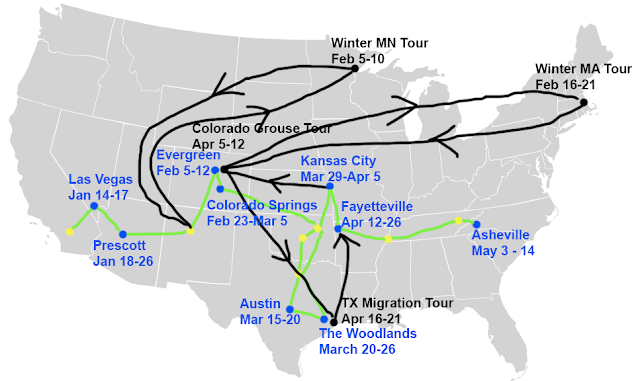
And that's why haven't written a thing since February. I am doing a lot of birding in the areas we're visiting, but the blog has really taken a backseat to logistics, pet-sitting, and pet-blogging (https://atailoftwositters.blogspot.com/). I've also done very little photography this year. It takes time to learn new areas, and we're moving around so fast that I don't learn anywhere well enough to shoot it efficiently; I'd rather just go birding since it's easier. I did take some really nice photos on my Colorado Grouse tour, so I'll try to get those up in the next few weeks.
So, that's what's happening with me at the moment. I hope to have more time to write later in the year, but please know that communication will continue to be sporadic for the next few months.
OK, planning and dogs call. Later!
Saturday, February 12, 2022
Post #213 - Waterfowl photos from Arizona
Since the female wasn't as contrasty as the male, I raised my lens a few inches so that I could capture a bit of texture on the water. I really like how the browns, tans, golds, and yellow blend together in this frame.
And lastly, I present this male Common Goldeneye. He wouldn't come as close as the others, so I had to slap the 1.4x teleconverter (TC) onto my lens. TCs can degrades the images when they're used on crappy lenses, but I don't have to worry about that with my 600 prime.
That's it for now. Later......
Monday, January 31, 2022
Post #212 - Biking for Birds in Nevada
Regular readers know that Sonia and I are traveling the US for at least the first half of 2022, but I haven't revealed our exact motivation/purpose until now! Our plan to exchange pet-sitting for lodging while home/owners travel might sound insane, but www.trustedhousesitters.com allows people to do exactly that. I kept this news on the down-low until now because Sonia and I wanted to get a second blog, A Tail of Two Sitters, up and running before we let the cat/dog/whatever out of the bag. While we have a loose itinerary of places/states we'd like to visit in upcoming months, we're generally going to allow the pet-sitting winds take us where they will. And that's how we landed in Henderson, NV from January 13-16. I did a bit of birding while we were in the area, most of it by bike, and I'll use this post to highlight some of the places I visited. Here's how we're carting the bike around!
Among three Henderson sites which I visited on my bike, the Henderson Bird Preserve on the east side of town was the best. The impoundments hosted a great number and variety of waterfowl, and desert birds like Costa's Hummingbird, Crissal Thrasher, Vermillion Flycatcher, Black-tailed Gnatcatcher, and Abert's Towhee lurked in the surrounding bushes. Over 300-species have been recorded at the reserve, and I tallied 60 across two morning visits, a breeding plumage Hooded Warbler an unlikely highlight. Beware - the HBP has very strict hours. Please consult this webpage for info. If I had only one morning to bird in the Las Vegas area, the I'd use it at HBP. Images of reserve below.
Neighboring Clark County Wetlands hosts similar species, but not in the same numbers as HBP. A series of trails winds through scrub and impoundments, and I think it's worth a quick pass even if it's a distant second to HBP. Same for Sunset Park. Though urban and heavily-visited, the park pond was loaded with waterfowl. The ducks are fed constantly, so super close views of Ring-necked Ducks, Canvasbacks, Redheads, Lesser Scaup, and American Wigeon were afforded. I hit the place on a cloudy afternoon, but it could be great for photography in the right conditions. Here is a map to show the relative locations of these HBP, CC Wetlands, and Sunset Park. It was easy to move between the three locations on the bike given our central location.
A bit farther afield, Red Rock Canyon on the west side of Las Vegas is totally worth a visit. It doesn't hold diversity or numbers of birds, but the landscape is amazing. There are loads of trails, and it would be easy to spend a full day exploring the area. The two dogs which we were watching loved scrambling over the stratified geology! Birds were few and far between, but I did find Rock Wren, Phainopepla, and Peregrine Falcon.
The bottom line is that there's an unexpected amount of birding and hiking to be done in the greater Las Vegas Area. While most who visit the city do so for other reasons, birders and outdoor enthusiasts will find plenty to occupy themselves over a three- or four-day stay.
Tuesday, January 11, 2022
Post #211 -- Some Southern California Photography
Sonia and I are back in the US! There was, however, some serious doubt as to our return from Chile; the Abbott Labs COVID AG-Card tests which we took with us kits were defective, so we had to cobble testing together the night before our flight from Santiago to Dallas (and onto Los Angeles). To compound the drama, Sky Airlines, a Chilean carrier, pushed our final domestic flight from Punta Arenas to Santiago back three hours, a circumstance which cut our connection time in Santiago from five hours to two. We landed in that capital, scampered off the plane, claimed our luggage, sprinted to the international terminal, checked into our American flight, and fought our way through immigration and security. By the time we hauled ass to the terminal's farthest gate, we had only ten minutes to spare. So yeah, getting back was a total circus!
I'll write more about Chile in future posts, but I'm gonna keep it simple this time around and post some photos I captured in Southern California just before we left. Recall that we've rented our San Mateo apartment and become digital/guiding nomads through September. Without a place of our own, we crashed with Sonia's dad in Riverside County for five days pre-Chile. There is some excellent photography to be had in that area, and I'll present a half-dozen shots that I captured across two sun-drenched mornings.
Those who read this blog regularly might recall a post from early-December where I described a choice run-in with Greater Yellowlegs, a common bird that managed to avoid my lens for the eight years since I departed Massachusetts. And wouldn't ya know it? A month after that entry, I had an even better crack at the species!


















